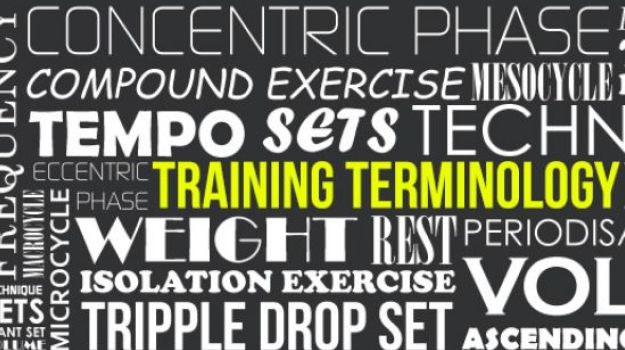When it involves strength training, it comes shrouded in jargons that go beyond terms like 'reps' and 'sets'. If you call yourself a fitness enthusiast and take your training seriously, it's about time you got the terminologies right. There exists a world of training concepts and methods that you should get acquainted with, rather than ignoring them. The only way to take your fitness routine a notch higher, is to embrace the unknown, understand it well and implement it in your regime. Let's begin.

TRAINING TERMINOLOGY
Periodisation - When the number of reps, sets, weights and intensity of workout varies from one session to another. You may also add variations to your workout on a weekly basis to achieve better results, rather than hitting a plateau.
Technique - The right technique is the basis of every exercise. Any exercise is almost useless if not done correctly. Remember, technique should always be prioritised and not compromised.
Reps - Stands for repetition or the number of times you are to repeat a movement pattern (exercise). You must always go through your full range of motion i.e complete the exercise and utilise muscle contraction, before repeating.
Sets - This is the accumulation of reps of a given exercise. A set is essentially the number of times you decide to do an exercise divided in a way to accommodate rest time in between. For example, you may want to do 30 push ups breaking them down in a set of three (10 reps each) with two rest breaks in between.

Rest - This is the time taken to recover between sets, exercises or training sessions.
Weights - Refers to the load you use for an exercise usually recorded in kilograms (kg). Some resistance equipment may be recorded in pounds (lbs).
Tempo - Stands for the duration/time your muscles are under tension. It denotes the speed at which you lift the weight up, bring it down and complete a rep. It is expressed as a four numbered-figure; the first and the third numbers denote the lifting/ lowering movement (concentric phase), while the second and the last numbers indicate rest/pause (eccentric phase).For example, if the tempo for your barbell curl is expressed as 2120, it denotes that you took two seconds to lift the barbell up, followed by a pause of one second, and then two seconds to lower the barbell. The last number is usually left out (zero) as it denotes the end of a rep, but in case of continuous training, it refers to the top/starting point of the exercise.
S (s) - Seconds
Volume - This refers to the number of muscles worked upon, the exercises, reps and sets performed during a single session.

Frequency - The amount of training sessions that are completed each week.
Isolation Exercise - These are exercises that focus on a specific muscle group, usually using a single joint movement pattern.
Compound Exercise - These are exercises that use multi-joint movement patterns and maximise the engagement of several muscle groups in a single exercise.
Concentric Phase - This is the 'effort' or 'lifting' phase of an exercise.
Eccentric Phase - This is the negative phase or 'lowering' of an exercise.
Microcycle - A training block over seven days.
Mesocycle - A training block over two to four weeks.
Macrocycle - An overall training period; i.e. The Lean Training System.
TRAINING INTENSIFIERS
Triple Drop Set (TDS) - This involves different weights, from heavy to heaviest. To perform a triple drop set, begin by completing a set with the heaviest weight that you can lift, do not rest, and then move on to another set by decreasing the weight slightly. Finally, move on to the final set reducing the weight further and performing until you hit concentric failure (when you can no longer perform any more reps with good technique).

Superset (SS) - This combines two exercises. To do a superset, perform a single set of an exercise, and then immediately, without rest, move onto the second one. Perform in sets followed by rest.
Giant Set (GS) - This combines three or more exercises. To do a giant set, perform a single set of exercise No. 1, and immediately, without rest, move onto a single set of exercise No. 2. Finally, move onto exercise No. 3 for a final set before resting.
Ascending Pyramid Set - These sets increase the weight whilst progressively decreasing the reps performed.
Descending Pyramid Set - These sets decrease the weight whilst progressively increasing the reps performed.
Pre Exhaust - This technique aims to pre-exhaust a muscle group by first performing single joint movement exercises followed by compound exercises involving multi-joint movement patterns. This helps in achieving a better muscular contraction.
Failure (F) - This refers to taking an exercise to concentric failure; meaning you cannot physically perform any more reps with good technique.Powered by BodyPowerDisclaimer: The opinions expressed within this article are the opinions of the author. NDTV is not responsible for the accuracy, completeness, suitability, or validity of any information on this article. All information is provided on an as-is basis. The information, facts or opinions appearing in the article do not reflect the views of NDTV and NDTV does not assume any responsibility or liability for the same.







